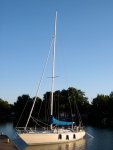venntim
New member
I've just added a bit length to the forestay as my mast has been a bit too upright for good pointing. It's a single inline spreader 7/8 rig with runners. The mast step is positioned as far aft in the mast foot as it goes, but the mast is still lightly leaning on the mast collar.
My question is that is there a danger of fatigue in the front section of the mast at the deck collar level? Or should I opt for a bit shorter toggle (changing it would mean taking the mast down again)? I haven't yet had a chance to measure the rake, but with an tried and true eye-balling method it looks ok, not too excessive.
Looking forward to your ideas!

My question is that is there a danger of fatigue in the front section of the mast at the deck collar level? Or should I opt for a bit shorter toggle (changing it would mean taking the mast down again)? I haven't yet had a chance to measure the rake, but with an tried and true eye-balling method it looks ok, not too excessive.
Looking forward to your ideas!

Last edited:
